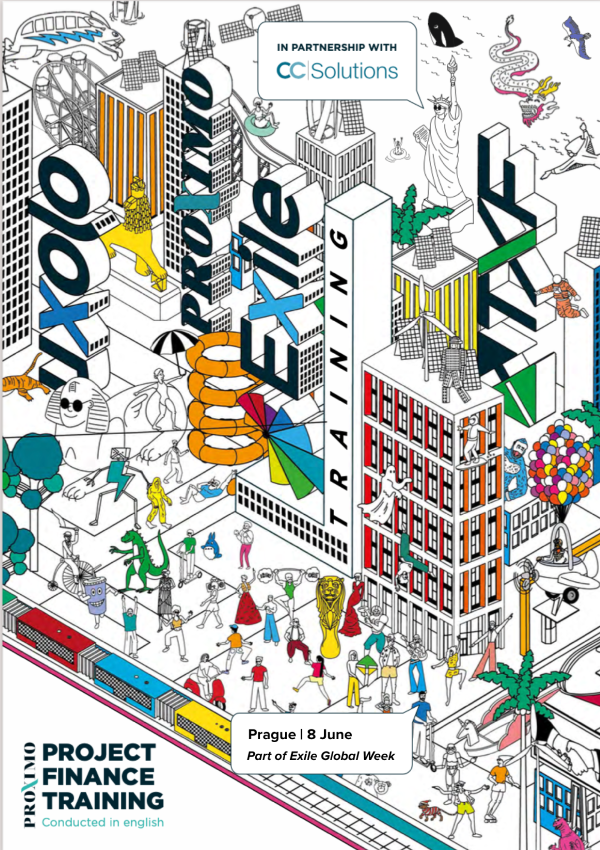Impact finance – the secret to scale is in the blend (part two)
Impact investment and blended finance – both key strategies in attracting private sector funding into energy transition, particularly in developing markets. So how to achieve them? In the second session of a two-part roundtable, Proximo, with support from AXA XL, invited a panel of experts from across the blended finance spectrum to discuss regulatory change, cost of debt and investor appetite.

A roundtable supported by:
Impact finance and investment is enjoying unprecedented appetite and demand on the back of climate change, energy transition and growing ESG awareness. But for all the positive sentiment, what is achievable from blended and impact finance given the global economic headwinds of inflation, rising project and commodities costs and a growing debt crisis in developing markets?
AXA XL and Proximo brought together a panel of experts from insurance, funds, commercial banks and DFIs to answer those questions and much, much more. If you have questions about blended and impact financing you are likely to find the answers below. And if you have not yet read part one of the roundtable please click here.
Panellists:

Proximo: What regulatory changes or initiatives would help maintain sustainable investment, and have policymakers responded robustly enough?
Nadia Nikolova: There are two areas in which I would love to see some change. One is the securitisation treatment of blended finance funds. Basel and Solvency regulated investors’ capital charge is substantially higher, and there are also the onerous reporting obligations that will fall on the originator should blended finance funds be considered securitisation. That arises as a problem every time we have any sort of subordination, even if that comes in an unfunded solution – you are always questioned is that a synthetic securitisation? So investors run away from it in Europe. Conversely it’s a completely different story in the US – so a clarification of what does not constitute securitisation is needed.
Recently regulators have actually scared participants in Europe even more because some of the funds did actually get classified as securitisation and some development banks have taken quite the capital charges hit – not a good precedent. So we need clarity. We've been talking and with the Commission and to get more clarity and support for blended finance, including the funded and funded solutions.
The second item I already mentioned is the treatment of ECAs, the differentiation between Basel and Solvency. Clarification of both of those regulations would make future flows higher.
Daniel Borrego Cubero: I agree with Nadia. It's interesting that we're talking about regulatory uncertainty on the investor side in developed jurisdictions. So imagine when you look at investees in developing markets – the need for regulator and investor education is massive.
Christopher Marks: Another item to add to Nadia's list is the UK's interpretation of Solvency 2 which applies to the matching adjustment requirements, and which from a prudential point of view – the matching of cash flows against insurance liabilities – is perfectly understandable. But there is a rigidity to the manner in which that requirement is applied, which for a number of the blended finance structures that we are working on is quite challenging – even and maybe particularly so in a jurisdiction where you have very sophisticated insurance (pension money) behind them that are comfortable taking a range of complicated infrastructure risks. These are the kind of investors that we want to get south of the Mediterranean and into other vulnerable jurisdictions. And it's remarkably hard. We can do things on the continent we can't do in the UK precisely because of this so-called matching adjustment requirement. The UK is discussing reforms in this direction, but not yet in a practical way that allows us to get these people involved, even when they would like to be.
Mahfuza Afroz: Some of the concerns raised are very valid, especially for the investee markets that we operate in – regulations could really use a boost. And to that point, IFC works very closely with regulators in emerging markets. We have teamed up with the Milken Institute in the US and Paris Europlace in France on an education program to train regulators to enhance their capital markets understanding. In addition, we are addressing the concerns around impact washing. We need to have common terms that define impact investments such that people and companies cannot get away with impact washing. Simplifying some of the regulations so they are more understandable and implementable are some of the things that IFC is focused on, and also trying to build consensus among regulators. We understand that we have a role to play in helping regulators build robust regulations around this theme.
Jordy van der Drift: Just to follow up on that point, it's very much true. For example, the EU taxonomy is very much written with a European lens and the moment you go outside of the European Union it's very difficult to get to the data points that you would need from a corporate in emerging markets. So it would be good to have that European regulation defined in a way that it also looks at countries that might be in a more transitional phase.
Another issue is if you look at how European infra debt is treated from a Solvency 2 perspective – it's interesting to see that there is some relief there. And you would hope that given the track record of development finance loans, something should be possible there as well to get some sort of a capital relief.
Bart Raemaekers: Certainly some rationalisation of reporting requirements on various participants in syndicates, for example, for environmental purposes would be useful. If we have a syndicate with 20 lenders and each lender has different reporting requirements on measuring impact, it is not workable for syndicators or our clients either.
And on the regulation side – it's a minor thing but it also relates to regulations in our borrowing member countries – where we try to use guarantees in local jurisdictions or maybe even insurance products, in some of the jurisdictions that we operate in there is no proper recognition by the regulators of guarantees. And if there's not a proper recognition in terms of capital relief and risk relief, then there's no benefit for banks or bankability. So I think it would be useful if in some markets regulators were educated on how these products should work and should be recognised.
My co-panellists have raised a lot of the challenges. It's a multi pronged, multi-dimensional challenge that we face. It is not just related to the treatment of blended finance infrastructure and others, but the more fundamental point that Bart was alluding to is how is our own product being treated? And the interpretations are so diverse and now potentially actually threatening for our product depending on which jurisdiction you operate in.
The interpretation of what type of capital relief or our insurance and funded product can bring to the table is actually preventing a lot of North American banks from being players in this area. So our collaboration with those banks is fairly constrained and we have to find creative ways to be parts of other structures to be able to provide any meaningful support. We're also spending quite a bit of capital in terms of lobbying together with industry associations to get a fair, articulate and well-informed hearing from regulators about what our product is.
We can work a bit more directly with multilaterals or non-regulated institutions, but if we don't bring along a lot of our corporate and commercial bank partners, we're going to be walking on one leg only. In short, if regulatory inconsistency continues, it's going to be the most important obstacle to the expansion and usefulness of our product.
Proximo: How do you foresee the financial ecosystem evolving over the next few years? And might it lack the capacity to meet demand? And can ECAs and Dfis move beyond providing countercyclical support to more consistently tackle climate change?
Jordy van der Drift: We hope that more pension funds will be mobilised within this space. As I said earlier, I think our current investors are very much capable of absorbing the risks that we're currently facing, or a majority of what we see. And there's huge potential in the pension fund market but – and it’s an important point – quality of data and availability of data need to be better. Sophisticated data – origination data, GEMs data, and proper risk/return data – would help all investors, whether they are bound by regulation or not.
Bart Raemaekers: In terms of the geography we work within (Asia), in the coming years we foresee a lot of climate finance big-tickets coming from countries such as Philippines, India, Uzbekistan and Thailand. Therefore we might see a little bit more of bond structures being deployed – the first steps are already happening. That may provide opportunities for institutional investors. Having said that, quite a bit of flow is in local currency, but I still think there will be some significant dollar volumes as well.
In Asia the development of thematic bond markets (green and blue bonds) is perhaps a little bit lagging, but I think that will also continue to grow. We also see promising signals that local currency tenors are increasing, which is very good for green and infrastructure finance given the large volumes that need to be raised. Some of the local bank systems will hit their limits and that could push projects to the capital markets.
Several clients are also asking us to mobilise more from other DFIs. And I think that's also an opportunity for insurers then to step in and help us write big tickets or support DFIs.
Proximo: Are you seeing institutional investor appetite for pre-construction in Asia?
Bart Raemaekers: A little bit, or rather I see developers now coming to the market in jurisdictions like Thailand for construction loans with the specific objective for those to be refinanced in capital markets. So the whole situation with completion risk has not been solved in Asia yet. As an MDB we are open and looking at opportunities to provide construction wraps for project bonds, although it is still in its infancy. But we do see that as part of our developmental mandate.
Daniel Borrego Cubero: There will continue to be interest in impact and more institutional investor interest in the space generally over the next few years. Regulatory uncertainty will also be reduced over time. And of course, I also think that an element of blended finance may help, bit it's not going to be the main driver of volumes.
Volumes at scale will depend on foundations being in place for those flows to balloon. But in terms of the capacity to meet demand, I think it very much depends on the supply and demand balance. Currently investment volumes are down, quality is also down across the board and the proportion of refinancing in the reduced financing volume is quite high in relation to the capex and FDI related financing activity that we see in our markets. Will some of that be covered by the local investor base? It may become larger over the next few years, but perhaps not to a very material scale as an element of undercapitalisation is likely to remain. This means that there will still be dependence on foreign flows, which in turn depend on stable operational and economic frameworks.
Through this and with the help of MDBs, emerging markets will become more investable. Of course before that we need to get through the current rate environment. When interest rates go down it will be because the outlook is improving and at that point, emerging market flows will come back across all products – loans and bonds. At that point MDBs will be less immediately needed. But our ongoing client and regulator, education and market and market-building role will remain in place.
Mahfuza Afroz: Bart and Daniel covered the potential evolution of the financial ecosystem. So, I want to focus on the countercyclical part of the question. The MDBs are always countercyclical – meaning they provide support when and where it’s most needed. But that's just part of our mission – financial sustainability and resilience is at the core of our business as well. Given the halo effect and the substantial capital at our disposal, we need to identify a pipeline of investable projects with clear profitability to serve as examples for others to scale and emulate.
The second thing is the climate part of the question. The World Bank Group made a commitment to align all its financial operations with the goals of the Paris Agreement in its Climate Change Action Plan 2021-2025. As part of this commitment, IFC began to align 85% of its new operations with the Paris Agreement in July 2023, and 100% from July, 2025.
As a result, IFC has been and will continue to focus on climate change and sustainability. So again, pushing back on the notion that we are only relevant when we're countercyclical, I think we're relevant during all cycles, but become especially relevant during times when other investors become a little wary of the economic clouds gathering on the horizon.
Nadia Nikolova: The future is a little bit unclear to me because of three aspects that are potential game changers – some positive and some negative.
On the positive side, we are seeing a great momentum around blended finance. The number of RFPs circulating is close to 5 billion, for various funds from MDBs and institutional investors. It's great to see the private sector also coming out, so that's very positive.
I think the complexity of the products drives away some of the interest and hopefully we are going to see some more simplification of these products in the future. The GEMs database that you already alluded to is an absolute game changer. The biggest thing for me is around recovery rates and not so much on the pricing side. If we don't get the recovery rates, it's useless, so let's see.
One aspect that I haven't gotten my head around is the whole China thing. We are thinking of the GEMs database and really looking forward to see what we've been told, which is that the historic track record has been very good. But with China constituting an ever-increasing lender in some of these markets, is the preferred creditor status, the ability of the MDBs to negotiate deals, going to continue to be strong. Or are we going to have longer times to recover and lower recovery rates? How is that new environment going to affect investors coming in and actually asking more questions? I think it's something we all have to consider when we think about our investment thesis in emerging markets.
Christopher Marks: I'm extremely hopeful about the range of experimentation, deployment of risk transformation instruments and getting sophisticated investors increasingly involved in areas that are relevant and in jurisdictions that they had not worked in previously.
I referenced this before, but I'll say it again – GEMs has relevance to the manner in which the rating agencies are able to crystallise the value of experience, both translating preferred creditor into ratings outcomes. Because the default proposition is to make assumptions about halo behaviour, which is why institutional investors tend to sit behind the multilaterals as the default position in some of the loan structures – for example, with some of the platforms the IFC has developed, because the halo effect is not deployed on the balance sheets, for example, of commercial banks, some of the positions where I sit alongside multilaterals don't provide any relief. So the release of GEMs data will allow us to develop new structures and to use multilateral instruments in different ways.
Furthermore, in an era of scarcity of concessional capital across all the tools that we’ve discussed, the question of minimum conditionality will come forward. I don't believe we understand the point of financial conditionality very well. We're comfortable with the notion of social, environmental positive externalities. But I'm not sure as we think about how multilaterals stand alongside other partners trying to develop similar or maybe even equally, if not more ambitious platforms, is each additional unit of multilateral contribution financially additional? Are there market benefits? Is there innovation? Is there market learning? Are investors really reducing their perceived economic or reputational risks through their participation in these structures? And if not, then the financial conditionality falls pretty quickly.
But multilaterals haven't really begun to grapple with that. We tend to default on larger projects without thinking carefully how each additional unit of capital is deployed. These are sensitive topics, particularly because money is tight in the G-7 these days and it's not going to get better as a lot of the big donors are distracted with a number of other considerations these days, so climate will have to fight for every penny.
Rafael Docavo-Malvezzi: It’s hard to come last to this question because a lot of the key points have been made and as insurers, we are not really the originators – we follow. But we have a vested interest in helping to provide solutions to make the bankability of certain projects possible. The role that we play is to hopefully provide innovative solutions that can make the deployment of capital easier and more efficient.
Daniel Borrego Cubero: I’d like to ask a question of Christopher since he is at the AfDB's annual meeting. It looks like almost every type of issuer or borrower in sub-Saharan Africa needs to pay well above 8%. And this seems to be adding to the continent's difficulties. I was wondering to what extent this has been featuring at the AfDB meeting and how it's seen as likely to evolve once the economic cycle turns?
Christopher Marks: The tensions are high. The case of Ghana might be quite particular, but I assure you it runs through a number of discussions about the manner in which risk transfer takes place. In the environment that you're describing there is an interesting tension – as sustainability concerns rise up there's a push naturally to move into the PPP space, off of public sector balance sheets. Again, the cost of financing is aggravated further as you move away from the presumed comfort of lending on a corporate or parastatal basis into the world where country risk and project risk interact. In sophisticated markets we contractually walk through this minefield, but it’s harder down here, so to speak, other than the big jurisdictions. Egypt will be okay. Morocco equally, but heading for the south is complicated.
There is no direct resolution to these conundrums. It is true, as you would expect from senior multilateral officials, that there's still an assumption that the deployment of tools and use of sustainability labels will bring institutional investors onto the continent. You could say it's a very hopeful stance. It's also true the steps needed to understand the risk reward equation these investors require presents challenges. The hard reality is pipelines are really thin, and particularly in the climate space another risk that is evoked is that all of you with your green mandates and your Paris alignments will go into the easier technologies to hit volume targets – that there will be lots and lots and lots of super cheap PV options and won't be as many nature based solution projects done. So that's also an issue that has come up on the continent. As I said, there's no happy, happy resolution, but these are some of the issues that have come up.
Proximo: What are the risks from rising interest rates, financial volatility and resulting reduced liquidity on impact investing? And are issues around debt sustainability in many emerging markets impediments to further lending in this space?
Rafael Docavo-Malvezzi: Daniel and Christopher talked about one of the fundamental obstacles here. From an insurer perspective we're putting a lot of attention on the how the Ghana and eventually Zambia cases are going to be resolved. The outcome from those resolutions is fundamental – a lot of insurers and a lot of insurance capital will be much more predisposed to provide capacity if these debt negotiations come to a reasonable and good outcome. Even if it means recoveries over long tenors, we are not afraid of that. There's more and more of an understanding among our management of what the end game is and what are the timelines that we talk about when we are doing this type of business. But we need resolution around these debt sustainability matters for us to really overcome some of the inherent obstacles and questions that we would be asked about supporting challenging jurisdictions.
Beyond that, yes, PVs and some of the renewables are easy wins. But I think that a lot of climate adaptation, a lot of the transition, is not being adequately quantified and put in a framework where we can get the value and the recognition within the ESG if we want targets.
Nadia Nikolova: I think there's a bit of a sentiment that we'll go back to a lower interest rate environment. Our view is that this is normal. In my lifetime there have been relatively low interest rate environments compared to the 90s.
I don't think there is significant buy-in from any investors that interest rates are going to get cheap again anytime soon. So if you can go liquid at the same yields, why wouldn't you invest in high yield bonds? Why wouldn't you invest in investment grade rather than blended finance that has structures and things you have to get your head around and you're locked in for an extensive period of time? These are the challenges facing the fundraising community. So communicating the relative value of what we are all trying to do here to investors – it's yet another hurdle to overcome.
Jordy van der Drift: A pension fund should have a long-term view and a long-term investment horizon – it's a 30-year risk that's being managed, not a five year risk. So in that sense, illiquidity and short-term risks are relatively unimportant. So as long as you have the stamina to ride out the cycle it should be okay. In the Netherlands we have pension funds regulatory reform and there is an interesting reform where there's a bit more flexibility and risk taking, especially for younger age groups going into a 30-year investment horizon. It’s a very positive reform.
Mahfuza Afroz: In terms of the rising interest rate environment, one thing that immediately comes to my mind is local currency versus dollar lending. It becomes even more relevant that we can lend in local currency to our borrowers given they are now looking at higher interest rates plus the FX risk that comes with it. Local currency financing is increasingly important to meet clients’ growing demand for such financing at competitive rates and with flexible features. It is imperative for IFC that it assists borrowers in riding out the cycle, that we find new structures, find innovative ways to be able to do business and sustain impactful investments despite all the challenges that come along.
Bart Raemaekers: We see the same – demand keeps coming. Accepted, we have seen some projects not being developed because of high interest rates. But if you look at the overall ADB portfolio, it's still doing very well. And so my concluding note would be that if you finance viable projects – projects that are good for the country and all the stakeholders – then even if you see some short term stresses, you will also see very high recovery rates because these projects just make sense.






